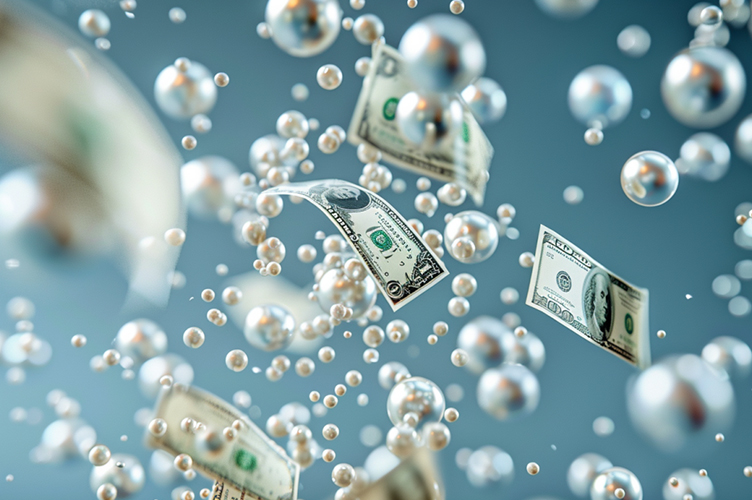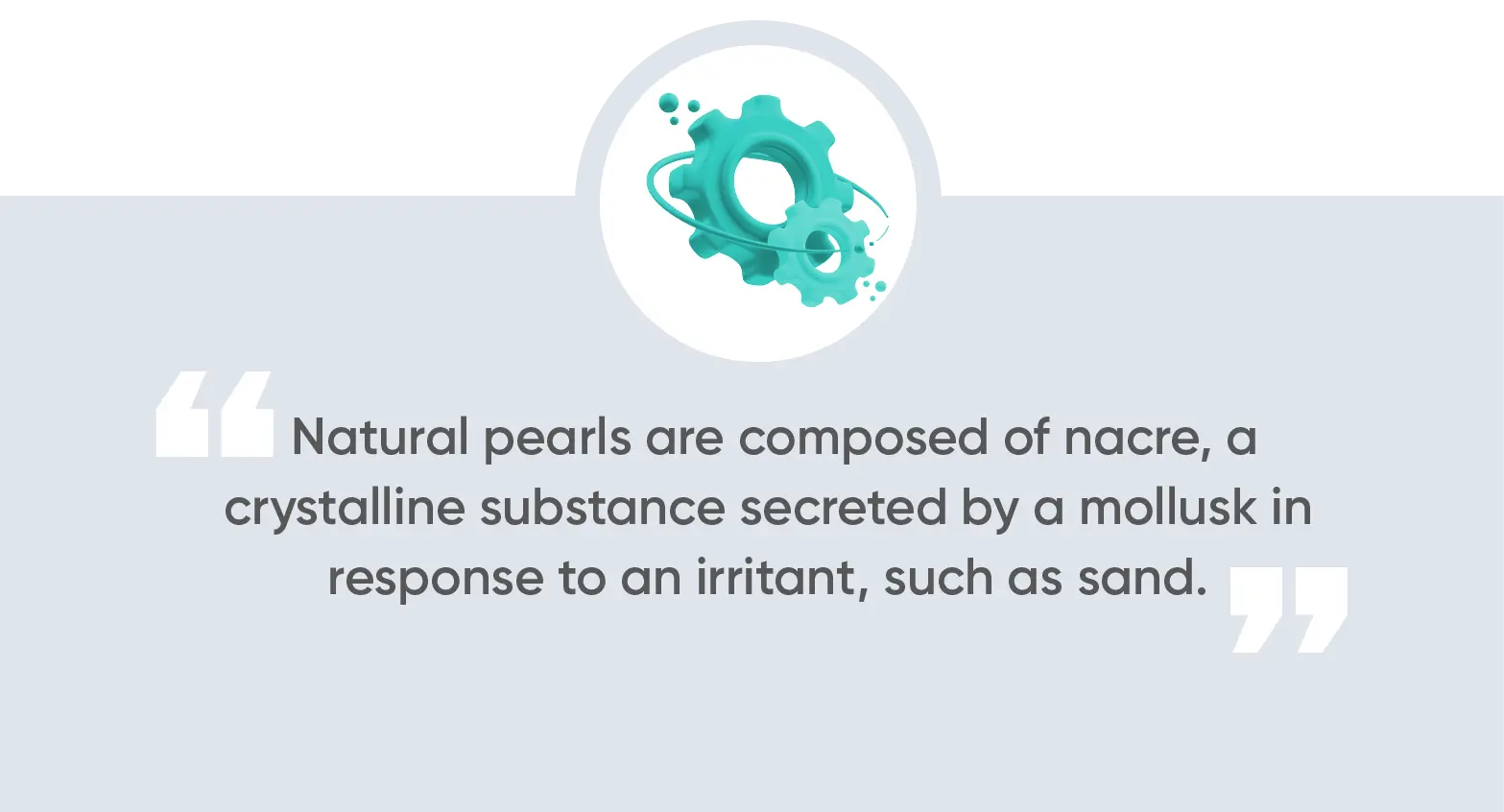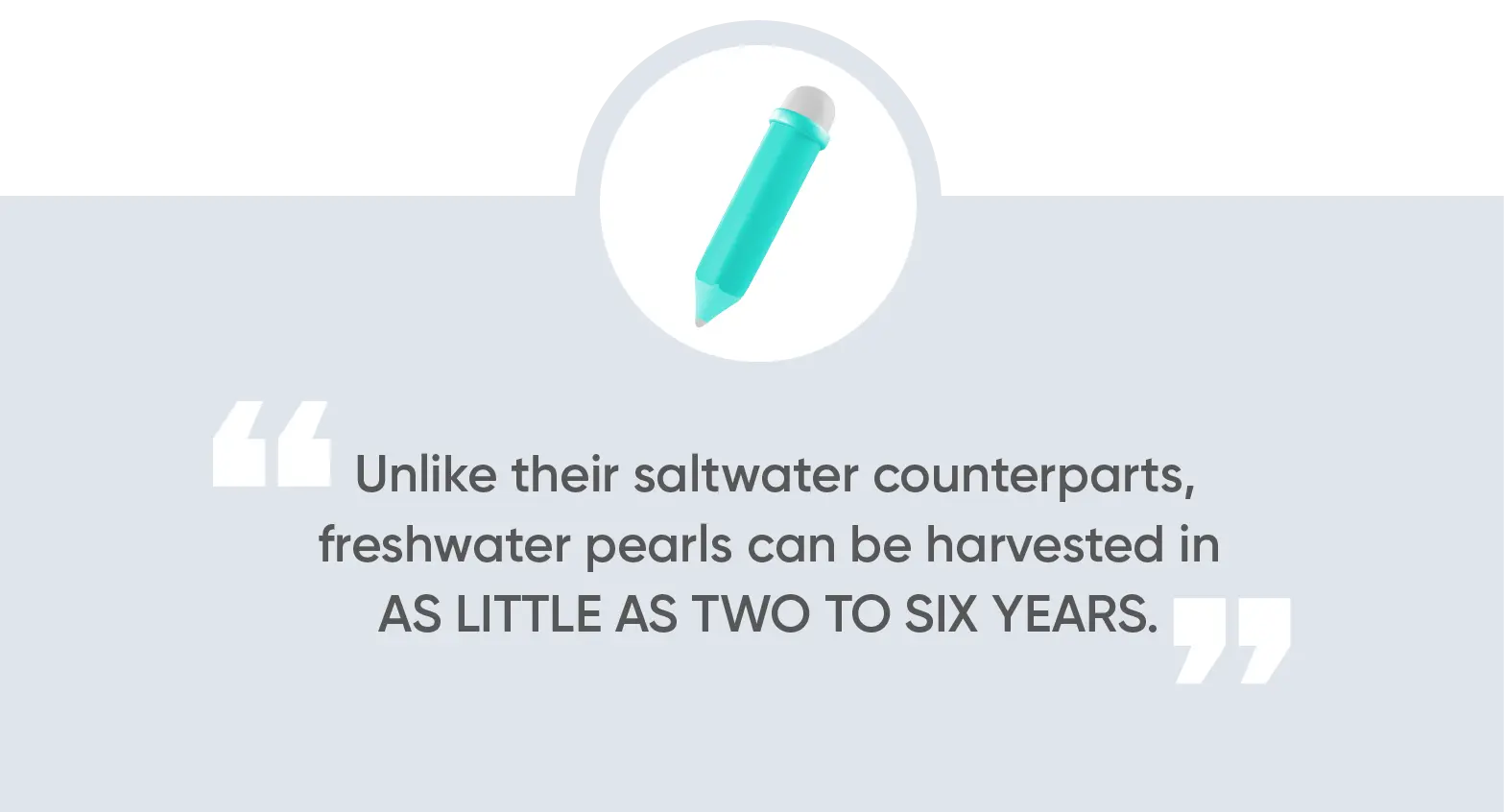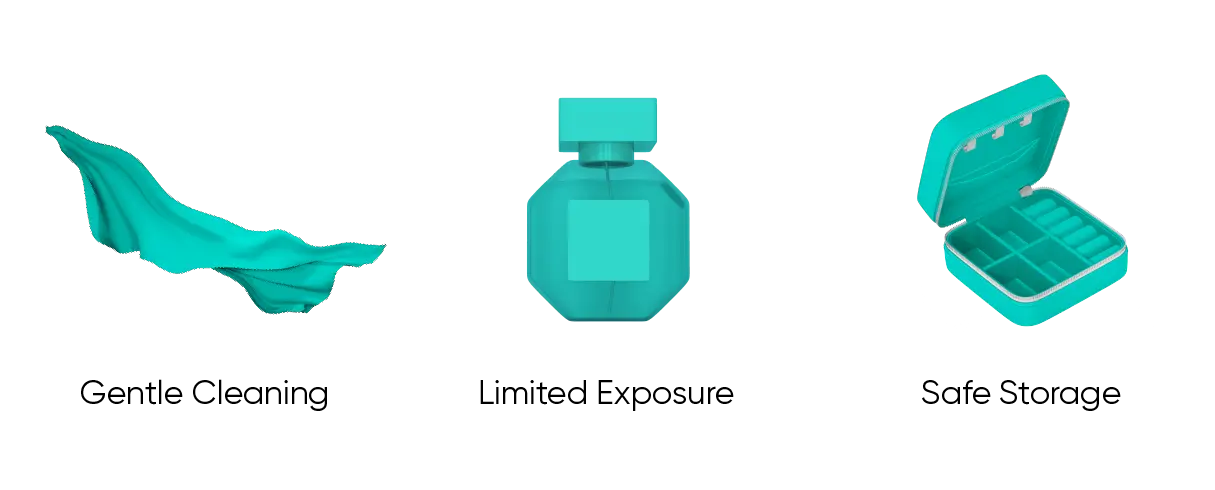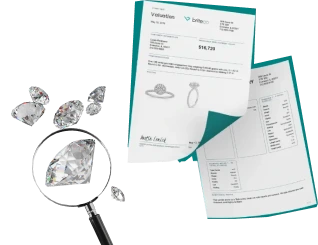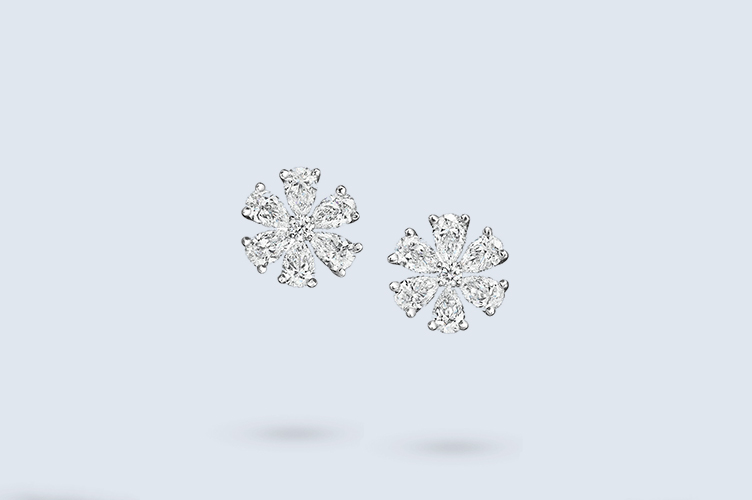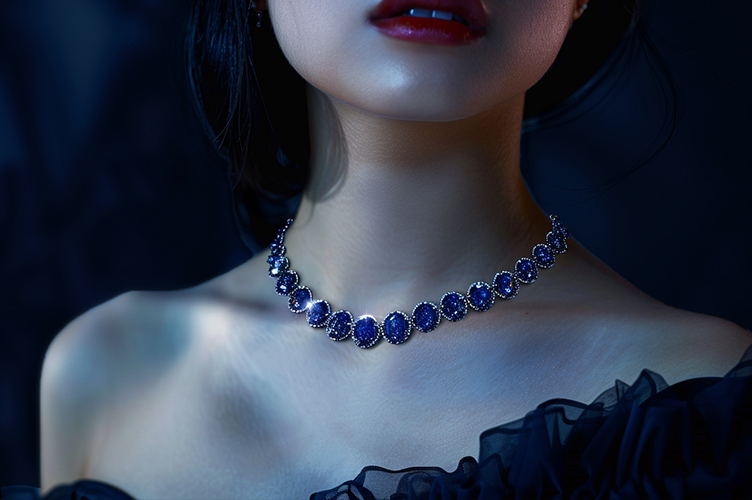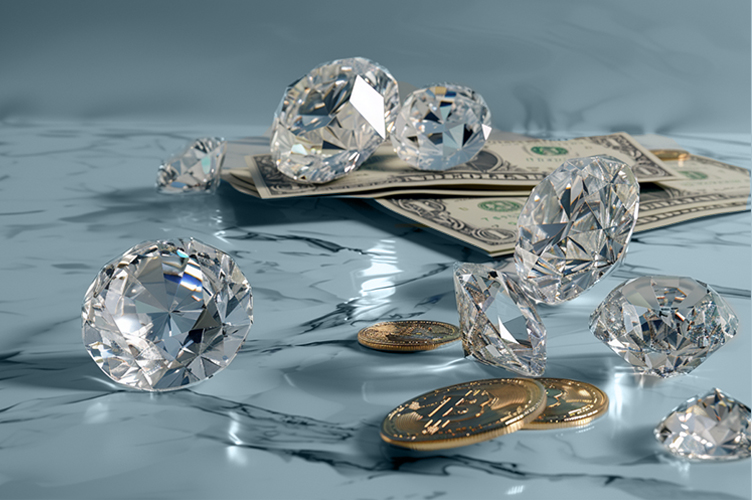How Much Are Real Pearls Worth? Understanding the Value of Real Pearls
From ancient civilizations to modern fashion runways, pearl jewelry transcends trends and stands the test of time. But how much does a pearl cost?
Keep reading to learn what goes into determining a pearls value.
What You Will Learn
How Are Real Pearls Formed?
Unlike synthetic counterparts, natural pearls form within mollusks’ soft tissues, primarily those of oysters and mussels, when the mollusk’s defense mechanisms activate to ward off irritants.
Real pearls boast a few primary features:
- Composition: Natural pearls are composed of layers of nacre, a crystalline substance secreted by a mollusk in response to an irritant, such as a grain of sand. The gradual layering process forms the pearl’s structure, contributing to its characteristic sheen and luminosity.
- Color Spectrum: White pearls might be the most iconic, but pearls come in many other shades. A pearl’s color is influenced by the type of mollusk and the environment in which it grew. Common hues include cream, pink, and black, with overtones ranging from rose and silver to green and blue.
- Size and Shape: Natural pearls come in various sizes and shapes, with factors such as mollusk type and cultivation conditions influencing the final appearance. While perfectly round pearls are highly desired, other shapes like button, drop, and baroque pearls showcase diversity. Pearl size and shape contribute to the overall allure and value of pearl jewelry, as well as the value of pearls in general.
Factors Influencing Pearl Worth
When determining “how much is a real pearl worth?” Various factors come into play, including type, size, luster, surface quality, and pearl cultivation methods.
Pearl Type and Origin
- Saltwater vs. Freshwater: Real pearls are broadly categorized as saltwater or freshwater pearls. Saltwater pearls, such as Akoya, Tahitian, and Golden South Sea pearls, tend to be larger and have a higher luster. Freshwater pearls, cultivated in mussels, come in various shapes and sizes, offering a more diverse range of options.
- Origin: The specific region where pearls are cultivated can significantly impact their value. Akoya pearls from Japan, for instance, are renowned for their round shape and high luster. Tahitian pearls from French Polynesia are prized for their dark colors, while South Sea pearls from Australia and Southeast Asia are valued for their large size and satiny luster.
Size, Shape, and Surface Quality
- Size: Most natural pearls rely on size for value. Large pearls are rare and command high prices. Cultured pearls are often measured in millimeters, with increments influencing their perceived value.
- Shape: While perfectly round pearls are highly desirable, other shapes such as oval, drop, and baroque exhibit unique charm. The rarity of a particular shape can influence market value, with perfectly round pearls typically fetching premium prices.
- Luster: Luster, the reflective quality that gives pearls their inner glow, is a primary determinant of worth. High quality pearls exhibit a bright, mirror-like luster, enhancing their overall beauty. Luster is influenced by factors such as nacre thickness and surface quality.
- Surface Quality: Surface quality is assessed based on the presence (or lack thereof) of blemishes, spots, or irregularities. Pearls with a smooth and clean surface are considered more valuable natural pearls than those with visible imperfections. Jewelers often use grading scales to evaluate surface quality, with flawless pearls commanding a higher market price.
Cultivation Methods
The main difference between natural and cultured pearls is that natural pearls form spontaneously, while cultured pearls are intentionally cultivated. The method used to cultivate pearls significantly influences value, and a cultured pearl, formed with human intervention, can vary in quality based on the cultivation technique employed. Pearls cultivated using more traditional and time-intensive methods may command higher prices due to their perceived authenticity and rarity.
How Are Pearls Cultivated?
Cultured freshwater pearls are a result of ingenious farming techniques. Pearl farmers carefully insert a small piece of mantle tissue into a mollusk, stimulating the natural pearl-forming process. Unlike their saltwater counterparts, freshwater pearls can be harvested in as little as two to six years. This efficiency has increased the availability of pearls and made them more affordable to a broader audience.
While natural pearls are celebrated for their rarity and organic formation, cultured pearls have become the backbone of the modern pearl industry.
The Market Value of Pearls: How Much is a Pearl Worth?
As explained, the value of a pearl is influenced by a multitude of factors, resulting in a considerable range in market value. Various factors, including type, size, luster, surface quality, and the intricacies of cultivation and pearls costs.
On average, natural pearls and high quality pearls sell for anywhere from a few hundred dollars to several thousand dollars, with exceptional pearls commanding prices that reflect their unique qualities.
Popular Types of Pearl Jewelry
Popular types of pearl jewelry range from classic designs to contemporary trends.
- Modern Pearl Necklace: A classic symbol of refined beauty, pearl necklaces come in various styles, including single strands, multi-strands, and graduated designs.
- Pearl Earrings: From South Sea pearl earrings to simple studs, pearl earrings are versatile accessories that effortlessly transition from casual to formal.
- Vintage Pearl Jewelry: Embracing the charm of bygone eras, vintage pearl necklaces often feature intricate designs, combining pearls with precious metals and gemstones.
Tips for Cleaning and Caring for Natural Pearls
Maintain your natural pearls with proper care and cleaning.
- Gentle Cleaning: To preserve real pearls, gentle cleaning is essential. Use a soft cloth to wipe away any accumulated dirt or oils. Avoid abrasive materials that may scratch the delicate surface.
- Limited Exposure: Natural pearls are sensitive to chemicals and extreme conditions. Limit exposure to perfumes, cosmetics, and direct sunlight, as they can diminish pearls’ natural radiance over time.
- Safe Storage: Storing pearl jewelry in a soft pouch or a lined jewelry box helps protect it from scratches and abrasions.
FAQs
Are pearls expensive?
Yes. The cost of pearls can vary significantly, with some varieties, like natural pearls, being particularly valuable.
How much are real natural pearls worth?
Real natural pearls differ in value based on factors like size, shape, color, surface quality, and rarity, making their worth highly variable.
How much do pearls cost?
The cost of pearls varies widely, ranging from affordable options like freshwater pearls to high-end varieties like South Sea pearls.
What are the most valuable natural pearls?
The most valuable natural pearls stand out due to their rarity, unique formation, and unparalleled beauty. The most valuable pearls are created without human intervention, emerging from oysters in response to natural irritants.
What makes the Golden South Sea Pearl special compared to other pearls?
The Golden South Sea Pearl is distinguished by its exceptional size, radiant golden hues, and lustrous surface.
What’s the difference between real and fake pearls?
Fake pearls, often made from glass, plastic, or other synthetic materials, may mimic the appearance of the real deal. The distinction becomes apparent upon closer inspection. Genuine pearls have a unique luster and texture that imitations struggle to replicate.
Protect Your Investment
At BriteCo, we help you safeguard your investments, including investments in pearl jewelry, with our comprehensive coverage against loss, theft, and damage. For more information, use our online tool and get a personalized insurance quote.

